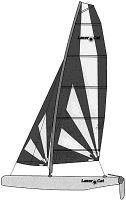Laser Cat
High-Performance Catamaran
I love to sail fast too. I'm not crazy about getting wet, but on the right sunny, warm, summer day a blast across the bay in this little catamaran rocket would be loads of fun. There is no question that one legitimate way to objectively measure sailing enjoyment is in knots.
The Laser Cat will reward your efforts with performance. I often tell beginning sailors to learn the basics of sailing in a dinghy. Small cruising boats are too forgiving to ever allow you to hone the skills required for fast, safe sailing. Racing a dinghy is better. The first year spent quietly bringing up the rear will fade quickly once you eventually beat someone.
Three years ago my wife and I thought we would become Tasar racers. Okay, we were a little, no, make that a lot over the weight limit. On top of that, we were just plain slow. It helped after I discovered my wife was putting the daggerboard in backwards. "But you told me to put it in that way!" In fact, we were so far behind one evening that the committee boat sent the Boston Whaler out to us to tell us we didn't have to finish. I guess they wanted to get home in time for "Seinfeld." My biggest lesson was in humility. My wife learned that she preferred to steer. But that's another story.
Designed by Yves Loday, the Laser Cat was intended to introduce juniors to the thrills of cat sailing. The hulls are shapely and symmetrical, and are Rototech-molded in Tecrothene 121. This is a linear, high-density, UV-stabilized, thermo-plastic material combined with a stress-free homogeneous sandwich with an inner closed-cell structure for rigidity. You know, the basic stuff. It's tough, durable and usually heavy. The 15-foot, 9-inch Laser Cat weighs 286 pounds according to the brochure. That's 130 pounds heavier than the monohull Tasar at nearly the same overall length. The durability of these hulls allows you to retract the rudders and sail at full speed onto the beach.
There are no centerboards or daggerboards. Apparently the unusual hull profile with its deep, sharp belly provides all the lift you need. I read the in-depth sailing trials report from England and there is no mention whatsoever about the boat's ability to go to weather. The report seems to cover all other aspects in great detail. I'm just going to have to sail this boat myself to determine its weatherliness. Damn.
At first glance, the rig looks normal. The main is a fat-head shape similar in planform to many sailboard sails, but there is no boom. The mainsail is reefed by dropping the halyard, tidying up the lower sail slab with built-in bungee lines, then rehoisting. Most dinghies use halyard locks at the mastheadÑthese can be very frustrating. The Lasar Cat leads its main halyard to the mast base. According to the British sailing trials, the mainsail is "a doddle to drop." The jib rolls up on a roller-furling drum. There is a unique A-frame-type rigid bridle for the headstay that allows excellent headstay tension. Jibing is easy with no boom to threaten your head.
The Laser Cat would provide an easy way to experience the thrills of multihull sailing in a very well-thought-out and well-executed package that should appeal to sailors of a wide range of skill levels.

Comments